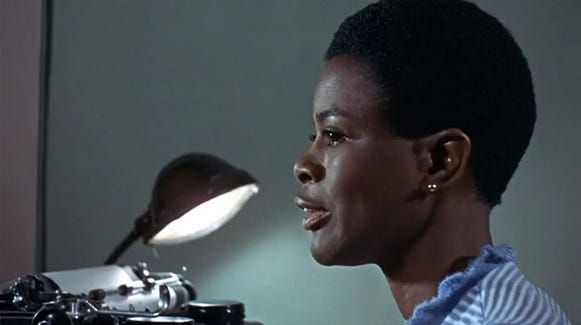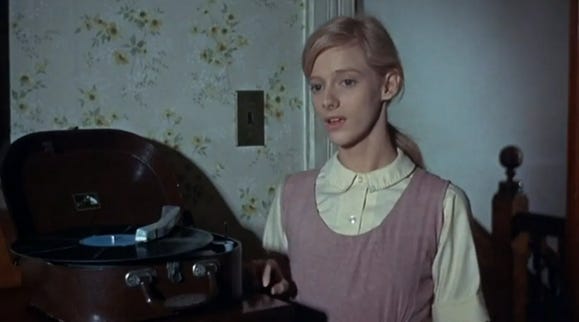This is why we watch the movies nominated for Best Actor: because watching a good performance is a sight to behold. Alan Arkin gives a special one in The Heart Is a Lonely Hunter.
The deaf John Singer (Alan Arkin) moves to a small Georgia town and rents a room from the family of teenage Mick (Sondra Locke). Mick initially considers Singer a “dummy” but soon recognizes a loneliness and lack of fulfillment in him that she too feels. For him, it stems from his disability1, while hers comes because her family is poor and she can’t pursue her dreams of music.
The parts with Singer and Mick are tender and understated, full of deep respect for the characters. You can’t tear your eyes from either actor. We follow them to their unhappy endings: Mick has to drop out of school to support her family and loses her virginity to an older boy. Singer’s deaf friend Spiros (Chuck McCann) dies in an institution and then Singer kills himself.
Unfortunately, there’s another, less realized, subplot that focuses on the white-hating Dr. Copeland (Percy Rodrigues) and his daughter Portia (Cicely Tyson). This contemporaneous review described it as “a Black Power version of ‘Secret Storm,’” which was a devastating burn back when people knew what “Secret Storm” was.
Rating: 8/10, deeply affecting, except for the parts that aren’t.
Cast and Crew
We last saw Alan Arkin in the comedy The Russians Are Coming, the Russians Are Coming. Between that film and this one, he co-starred with Audrey Hepburn in Wait Until Dark (1967) and took over the title role for the third Pink Panther movie, Inspector Clouseau (1968).2 You’d think The Heart Is a Lonely Hunter would blast Arkin into the stratosphere, but this’ll actually be the last time we’ll see him in this column.
After THIaLH, Arkin got above-the-title credit for the role of Yossarian in Catch-22 (1970), Mike Nichols’ adaptation of Joseph Heller’s novel. Unfortunately, it was overshadowed by another antiwar black comedy from that same year: M*A*S*H. Here’s the thing: Catch-22 is both way funnier and way more tragic than M*A*S*H, especially in scenes like this one.
Arkin’s career continued: he directed Little Murders (1971) and starred in films like Last of the Red Hot Lovers (1972, based on a bad Neil Simon play)3 and Freebie and the Bean (1974, a proto-buddy cop film). The end of the decade had him starring with Peter Falk in The In-Laws (1979), which is also kind of a buddy cop film, except the buddies’ children are getting married and also one of the buddies is a dentist, not a cop.
Arkin had fewer hit in the ‘80s and, by the ‘90s, had reinvented himself as a supporting actor extraordinaire playing different shades of “grumpy old man.” If you scroll through his filmography, you’ll recognize a lot of these films, but the two he’s best remembered for being in are Little Miss Sunshine (2006, for which he won an Oscar) and Argo (2012). He also did TV, notably co-starring in “The Kominsky Method” (2018–2021).
This was Sondra Locke’s first film role. Beyond this, Locke’s (unfortunately) best known for her work—and relationship—with Clint Eastwood. She starred with him in (deep breath) The Outlaw Josey Wales (1976), The Gauntlet (1977), Any Which Way but Loose (1978) and its sequel Any Which Way You Can (1980), Bronco Billy (1980), and Sudden Impact (1983). Those are some uneven films, sure, but Locke’s not the problem. Critic Joe Queenan disagrees, claiming “[Locke] played Linda McCartney to Eastwood’s Sir Paul.” Let’s be clear: this is a bad take.
Besides the acting, Locke was known for her long-term domestic partnership with Eastwood while both were married to other people. Their breakup was acrimonious: she sued him for palimony, he got her blackballed in Hollywood, she sued him for fraud. As Karina Longworth points out, many of Locke’s 2018 obituaries omit her name but include Clint’s. Let’s do our (extremely small) part in altering this narrative: Locke was wonderful in The Heart Is a Lonely Hunter, don’t you forget it.
Playwright Tennessee Williams once called the Georgian author Carson McCullers the “greatest prose writer that the south produced.” “The Heart Is a Lonely Hunter” (1940) was her first novel but she was no one-hit wonder. You should also know:
“The Member of the Wedding” (1946), about a lonely girl (notice a theme?) who wants to go on her brother’s honeymoon. This one was made into a movie with Julie Harris.
“Reflections in a Golden Eye” (1941), about a closeted Army officer, his unfaithful wife, and a voyeuristic private. This one was made into a movie with Marlon Brando and Liz Taylor.
The novella “Ballad of the Sad Café” (1951), about small business owner Miss Amelia, her hunchbacked cousin, and her violent ex-husband. This one was made into a movie with Vanessa Redgrave.
Quick Hits:
Theater Hall-of-Famer Stacy Keach made his film debut in this one. “Jeopardy!” mostly wants you to know he played PI Mike Hammer on TV, which is…myopic. We’ll see Keach in a few more supporting roles.
I ripped Cicely Tyson up top but she’s a legend. She gets a Best Actress Oscar nod for Sounder (1972), which we’ll be watching, so we’ll discuss her career then.
The Trivia
Singer learns that Mick is interested in music when he sees her loitering outside a concert held by a visiting orchestra. They’re performing two symphonies, so let’s talk symphonies—starting with, like, what even is a symphony?
Through the Renaissance and Baroque eras, “symphony” was used to describe all sorts of different styles of music, but today’s definition pegs it as a composition written for a full orchestra4 and structured in multiple movements5 with contrasting tempos and moods. Symphonies are abstract, long-form orchestral showcases, and you can compare other musical forms against that definition.
The rest of this section will be discussing “famous symphonies,” specifically those with fun nicknames. We’ll start with those of Austrian composer Joseph Haydn (1732–1809), who is known as the “Father of the Symphony.”6 Haydn composed over one hundred of them, including the ones below:
“Farewell”: the musicians get up and leave one by one during the symphony
“Surprise”: the andante has some surprisingly loud chords to wake you up if you’ve been snoozing.7
Haydn mentored both W. A. Mozart (1756–1791) and Ludwig van Beethoven (1770–1827), and accordingly, those guys have symphonies you’ve gotta know too.
First, Mozart: his two most well-known named symphonies are “Prague” (which premiered in Prague, go figure) and “Jupiter” (whose nickname comes from its grand, triumphant sound). “Jupiter” was Mozart’s 41st and final symphony; 41 isn’t a lot compared to Haydn, but it is a lot compared to our next guys).8
Okay: let’s do Beethoven’s big three, whose names and numbers you have to know.
Symphony No. 3 “Eroica.” It’s not erotic: “eroica” is Italian for “heroic.” It was originally titled “Bonaparte,” for Napoleon.
Symphony No. 6 “Pastoral.”
Symphony No. 9 “Choral.” This was Beethoven’s last symphony. It set poet Friedrich Schiller’s “Ode to Joy” to music.
Oh, also Beethoven’s Symphony No. 5 is also sometimes called “Fate”—though I figure most people just call it the “ba-ba-ba-BAAAA” symphony.
Beethoven dying after nine symphonies led to a supposed curse where great composers will die while writing their tenth symphony. Though Beethoven didn’t get a tenth, Johannes Brahms’ (1833–1897) Symphony No. 1 is sometimes nicknamed “Beethoven’s Tenth,” since, musically, he sorta picked up where Beethoven left off.
Now some guys with only one or two symphonies with names you need to know:
Franz Schubert (1797–1828) – “Unfinished” (1822). I’m not sure why this is his most famous when he’s got other perfectly good finished symphonies.
Robert Schumann (1810–1856) – “Spring” (1841). He lied: it was written during winter. Also noteworthy was his later symphony, “Rhenish,” about the Rhine, ish.
Felix Mendelssohn (1809–1847) – “Scottish” (1842), inspired by Scotland’s terrible weather. Also notable is his “Italian” (1833), about how many Chinese tourists there are in Italy.
Hector Berlioz (1803–1869) – “Symphonie fantastique” (1830). Kind of a flex titling your symphony “fantastic.”
Pyotr Ilyich Tchaikovsky (1840–1893) – “Pathétique” (1893). Tchaikovsky didn’t have the confidence of Berlioz.9
Antonín Dvořák (1841–1904) – “From the New World” (1893), inspired by the Czech Dvořák’s time in America.
Dmitri Shostakovich (1906–1975) – “Leningrad” (1941), composed during the Nazi siege of Leningrad.
Leonard Bernstein (1918–1990) – “Jeremiah” (1942), “The Age of Anxiety” (1949), and “Kaddish” (1963).
Those guys aren’t exclusively remembered as just being “symphony guys,” but Gustav Mahler (1860–1911) kinda was. In fact, he pulled a Beethoven, dying while writing symphony #10. The two nicknames you need for his works: Symphony No. 2 is “Resurrection” and Symphony No. 8 is the “Symphony of a Thousand” (his symphonies were grand, requiring lots of musicians).
Odds and Ends
Director Robert Ellis Miller was behind the camera for this one; we’ll see his work again in the ‘80s…Sondra Locke was famous for lying about her age, good for her…IMDB’s Trivia page says Montgomery Clift was considered for the Singer role in the early ‘60s; this is basically their only trivia fact not about Sondra Locke’s age…“Gaelic Symphony” by Amy Beach (1867–1944) was the first symphony composed and published by an American woman…Sondra Locke was also in Willard (1971), about a dude who uses rats to kill people…the Supreme’s “I Hear A Symphony” is a good song, as is the Verve’s “Bitter Sweet Symphony.”
Though Singer’s deafness paradoxically makes him an ideal listener for others who are similarly isolated—he can read lips and understand but can’t verbally respond. This just leads to him feeling more isolated.
Arkin’s, what, the George Lazenby of Inspectors Clouseau? He took over from Peter Sellers for a poorly-received one-off, then watched as Sellers retook the role.
He also directed the Neil Simon play “The Sunshine Boys,” about grumpy former vaudeville partners on Broadway. We’ll be watching the film adaptation.
A symphony orchestra tends to have 80+ musicians. Compare that to a chamber orchestra, which’ll have 10 to 40 players.
Typically four movements, typically like this:
Fast (allegro, cheerful), usually in sonata form (two themes, developed, then repeated)
Slow (andante, walking, or adagio, slowly)
A dance: a minuet (whose name is from the French for “small”) or scherzo (“scherzo” is Italian for “joke”)
Fast, often in rondo form (a main theme that alternates with others)
He’s also called the “Father of the String quartet.” All this fertility netted him the nickname “Papa.”
You should also be aware of “Clock,” “Bear,” and “Drumroll,” whose names are all, y’know, descriptive. Haydn also named a series of symphonies after Paris and another series after London.
Others from Mozart: “Paris” (written for a trip to Paris), “Linz” (written while visiting Linz, Austria), and “Haffner” (commissioned by the Haffner family). I guess most of the work went into the symphonies, not the naming.
Actually, the symphony was called “Pateticheskaya,” in Russian, meaning “passionate,” but was mistranslated into French. Also, you might want awareness of a few of Tchaikovsky’s others: “Winter Daydreams,” “Little Russian,” and “Polish.”










first